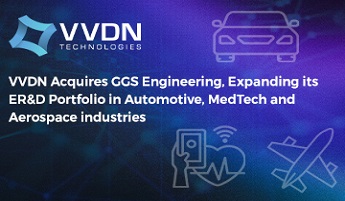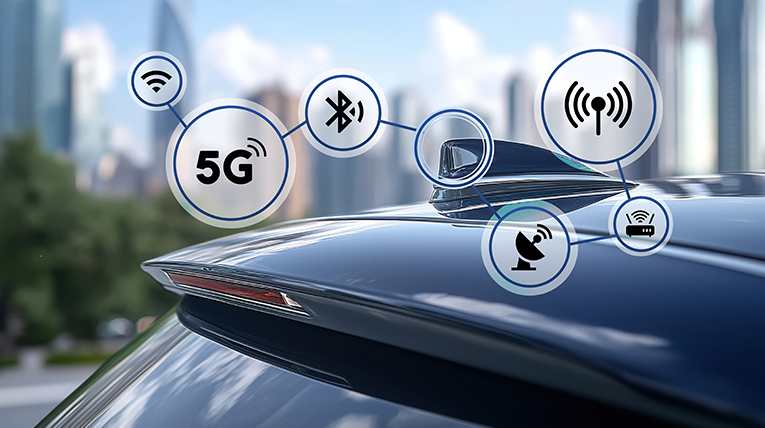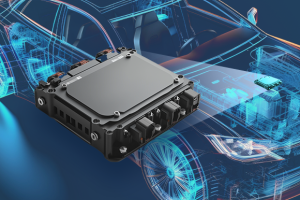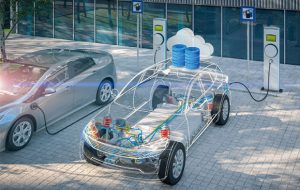When we talk about Software-Defined Vehicles (SDVs), the conversation often revolves around high-performance compute platforms, centralized architectures, or software stacks. But one of the unsung heroes of this transformation is the automotive antenna. Without robust antenna systems, none of the cloud connectivity, real-time data exchange, or over-the-air updates that define SDVs would be possible.
Antennas have come a long way from the days of whip rods sticking out of the car body. In SDVs, they are no longer passive pieces of hardware; they are smart, adaptive, and software-managed subsystems that form the backbone of vehicle connectivity. Let’s unpack how they’ve evolved, the challenges they face, and where they are headed.
Table of Contents
From Whip to Software-Defined
In older vehicles, antennas were single-purpose, AM/FM for entertainment and GPS for navigation. As cars became connected, shark-fin modules emerged, packing LTE, Wi-Fi, GPS, and radio into compact housings. Performance started to matter as much as aesthetics.
Now, in SDVs, antennas are multi-role players. They don’t just “receive signals”; they enable a huge set of capabilities:
- V2X (Vehicle-to-Everything): safety-critical communication with extremely low latency.
- 5G NR & LTE: cloud connectivity, infotainment, and even vehicle teleoperation.
- GNSS: precise positioning for ADAS and autonomous functions.
- UWB: secure digital keys and in-cabin localization.
- Wi-Fi 6/7: hotspots and data offloading.
- Satellite connectivity: coverage in remote or emergency situations.
This diversity of use cases is why antennas in SDVs must be designed as future-proof, reconfigurable systems, not static components.
Why Antennas Are Harder in SDVs
If you think antennas are just about “signal strength,” SDVs prove otherwise. They bring a unique set of challenges:
- Multi-band coexistence: A single car today may need antennas for sub-6 GHz, mmWave, UWB, and satellite, all operating simultaneously. Avoiding interference between them requires advanced isolation and filtering.
- Centralized vs. distributed design: Should antennas live in one shark-fin module, or be spread across mirrors, bumpers, and glass? Centralization simplifies service, but distribution improves coverage and redundancy.
- Integration with HPC: Antennas now connect to high-performance computers running software stacks. This means one antenna chain could dynamically switch between 5G uplink and C-V2X broadcast, based on software priorities.
- Thermal and EMC concerns: High-power 5G generates heat, and multiple radios packed in small spaces can interfere with each other if not carefully engineered.
- Aesthetics vs. RF performance: Designers want invisible antennas in glass or body panels, while engineers fight to maintain gain, directivity, and polarization.
In other words, antennas in SDVs are at the intersection of RF engineering, mechanical design, software, and vehicle architecture.
The Tech Shaping the Future
To meet these demands, antenna technology is getting a serious upgrade. Some of the big shifts include:
- MIMO (4×4, 8×8): pushing higher throughput for 5G.
- Beamforming and phased arrays: essential for mmWave to dynamically steer signals.
- Active antennas: integrating low-noise amplifiers, tunable filters, and adaptive circuitry.
- Transparent glass antennas: embedding conductive films in windshields to balance design and performance.
- Reconfigurable intelligent surfaces: still emerging, but promising adaptive coverage using smart materials.
What’s different in SDVs is that software is in the loop. It’s not just hardware design, machine learning models now adjust beam patterns, optimize performance based on environment, and even predict failures. Software stacks extend antenna lifecycles by enabling over-the-air updates for new protocols, something unimaginable a decade ago.
Testing Antennas for SDVs
Testing antennas in SDVs isn’t business-as-usual. It’s far more rigorous because they are tied directly to safety and reliability. Some essential validations include:
- Anechoic chamber testing for gain, efficiency, and radiation patterns.
- Over-the-air testing under multipath and Doppler conditions.
- SIL and HIL setups where antenna models are validated in software-defined stacks.
- EMC/EMI compliance with global automotive standards.
- V2X-specific validation for latency and packet delivery under congestion.
Simply put, an antenna is no longer a “fit-and-forget” part. It’s a system that requires continuous validation alongside software updates throughout a vehicle’s lifecycle.
Where We’re Headed
Looking ahead, antennas will become modular smart-antenna units, combining the physical antenna, RF front-end, and radio into a single package. These will be managed by AI-driven software that predicts failures, optimizes resources, and ensures resilience against changing network environments. With zonal architectures becoming mainstream, antennas will integrate more seamlessly, reducing cabling and complexity. And as hybrid 5G+ satellite systems mature, vehicles will enjoy truly global connectivity.
The big shift is clear: antennas are evolving from passive enablers to intelligent, software-defined subsystems — and they’ll be as critical to the SDV as the HPC itself.
VVDN’s Perspective and Expertise
At VVDN Technologies, we see antennas not as isolated hardware but as core enablers of the SDV vision. Our expertise spans the design of multi-band automotive antennas covering 5G, V2X, GNSS, Wi-Fi, UWB, and satellite communication. We bring strong capabilities in:
- RF simulation and design for multi-band performance.
- RF PCB and Hardware Design for Antenna
- EMC/EMI analysis and optimization for automotive environments.
- Anechoic chamber validation for gain, efficiency, and beam performance.
- System integration with HPCs, ensuring antennas are software-defined and future-proof.
- End-to-end services, from prototyping to mass production.
With deep domain knowledge in automotive electronics, connectivity, and system integration, VVDN partners with OEMs and Tier-1 suppliers to deliver antenna solutions that are robust, scalable, and ready for the software-defined future of mobility.








































